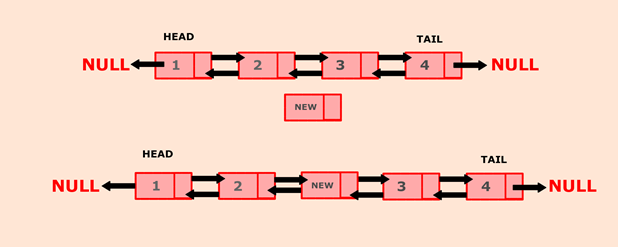In this program, we create a doubly linked list and insert a new node in the middle of the list. If the list is empty, both head and tail will point to the new node. If the list is not empty, then we will calculate the size of the list and divide it by 2 to get the mid-point of the list where a new node needs to be inserted.

Consider the above diagram; a new node needs to be added to the middle of the list. First, we calculate the size which in this case is 4. So, to get the mid-point, we divide it by 2 and store it in a variable mid. Node current will point to head. First, we iterate through the list until current points to the mid position. Define another node temp which point to node next to current. Insert the new node between current and temp
ALGORITHM:
- Define a Node class which represents a node in the list. It will have three properties: data, previous which will point to the previous node and next which will point to the next node.
- Define another class for creating the doubly linked list, and it has two nodes: head and tail. Initially, head and tail will point to null.
- addNode() will add node to the list:
- It first checks whether the head is null, then it will insert the node as the head.
- Both head and tail will point to a newly added node.
- Head's previous pointer will point to null and tail's next pointer will point to null.
- If the head is not null, the new node will be inserted at the end of the list such that new node's previous pointer will point to tail.
- The new node will become the new tail. Tail's next pointer will point to null.
a. addInMid() will add a node to the middle of the list:
- It first checks whether the head is null (empty list), then it will insert the node as the head.
- Both head and tail will point to a newly added node.
- If the list is not empty, then we calculate size and divide it by 2 to get the mid-point.
- Define node current that will point to head and iterate through the list till current will point to the mid node.
- Define another node temp which will point to node next to current.
- The new node will be inserted after current and before temp such that current will point to the new node and the new node will point to temp.
a. display() will show all the nodes present in the list.
- Define a new node 'current' that will point to the head.
- Print current.data till current points to null.
- Current will point to the next node in the list in each iteration.
PROGRAM:
Output: